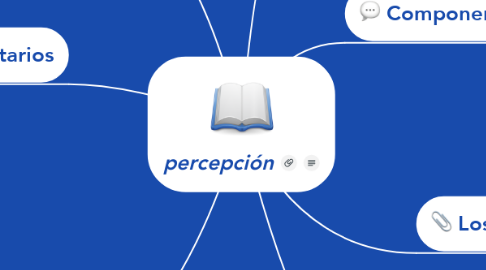
1. La percepción
1.1. Estímulo de la información
1.2. proceso mental interno
1.3. como mecanismo de supervivencia
1.4. construye un esquema informativo anticipatorio
1.5. Se apoya en la existencia del aprendizaje
1.6. pueda transmitir unas ideas, formar, reforzar o modificar actitudes
1.6.1. Training
1.6.2. Channels
1.6.3. International
1.6.4. Public Sector
1.6.5. Sales
1.6.6. Marketing Communications
1.6.7. Product Management
2. Organización
2.1. Relación entre figura y fondo
2.2. Agrupamiento o proximidad Este principio se basa en la idea de que las personas tienden a agrupar automáticamente los estímulos
2.3. Ley de cierre o clausura En estímulos abiertos o secuencias no completas, los individuos tienden a cerrar la percepción
2.4. Ley de semejanza Esta ley se apoya en el hecho de que los estímulos semejantes tienden a formar grupos perceptuales
2.5. Ley de buena continuidad Cuando las personas perciben un estímulo de una determinada manera, lo siguen percibiendo así durante un tiempo y dentro de un determinado contexto
3. Factores publicitarios
3.1. Para captar la atención y conseguir la percepción del público objeto en un anuncio gráfico se recurre a un buen diseño de todos sus elementos
4. Características
4.1. Es subjetiva
4.2. Condición de selectiva
4.3. Es temporal
5. Los inputs internos
5.1. Necesidad. Es el reconocimiento de la carencia de algo
5.1.1. Situational Analysis / Drivers
5.1.1.1. What is driving us to do this?
5.1.1.2. SWOT Analysis
5.1.1.2.1. Strengths
5.1.1.2.2. Weaknesses
5.1.1.2.3. Opportunities
5.1.1.2.4. Threats
5.1.1.3. Customer Findings - What have we learned from customers?
5.1.2. Competitive Analysis
5.1.2.1. Do we have competitors and threats in these target markets with the proposed offerings?
5.1.2.2. What are our competitors doing and how are they positioning?
5.1.2.3. How do we position against each competitor?
5.1.3. Target Customer(s)
5.1.3.1. Buyer Profile
5.1.3.1.1. Title
5.1.3.1.2. Industry
5.1.3.1.3. Geography
5.1.3.1.4. Business Size
5.1.3.2. Influencer Profile
5.1.3.3. User Profile
5.1.3.4. What do customers want and need?
5.1.3.5. What business problems do each of these customers have?
5.1.4. Customer Segmentation
5.1.4.1. Which customers or sets of customers do we sell to?
5.1.4.2. What are the target market segments that we want to go after?
5.1.4.3. What are the distinct problems for each segment of the market?
5.1.5. Total Available Market
5.1.5.1. New Prospects
5.1.5.1.1. How much of each target segment have we penetrated?
5.1.5.1.2. How much opportunity is available in each target segment?
5.1.5.2. Existing Customers
5.1.5.2.1. Can we up-sell existing customers?
5.2. Motivación. Es la búsqueda de la satisfacción de la necesidad.
5.2.1. Service Offer
5.2.1.1. What are we selling?
5.2.1.2. Product Definition
5.2.1.3. Pricing
5.2.1.4. Packaging
5.2.1.5. Positioning
5.2.2. Value Proposition
5.2.2.1. What is the Value Proposition to the Customer?
5.2.2.2. What pain are we solving?
5.3. Experiencia. El individuo aprende de las experiencias, y esto afecta al comportamiento.
5.3.1. Revenue Forecasts
5.3.1.1. Revenue and P&L Forecast (5 Years)
5.3.1.2. Revenue should be split out quarterly
5.3.2. Cost Analysis
5.3.2.1. Should include a description of the costs in entering this business and profitability analysis
5.3.3. Profitability Analysis
5.3.3.1. P&L for the offer to include gross margin, net income and break even analysis.

